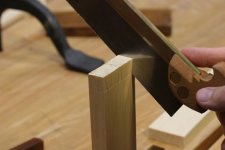Adam Cherubini said:
I think you would be better off sawing toe up, sawing the corners out. Putting the saw on the line and hoping for the best is not a technique, it's a stunt. Guys like Mike can pull it off. ...
Oh, I wouldn't call it a stunt. I taught 50 people at WIA and the recent LN Hand Tool Event in LA to simply start flat on the line. Both--sawing the corners and flat--are good methods and not necessarily interchangeable, depending on what one is sawing.
For instance, sawing tenon cheeks I saw the corners out simply so I can do what Schwarz says in rule #7. I don't, however, flip the stock and saw the other corner out and then flatten out to cut the bottom. By the time I have sawn the first corner, I am either on the line properly or off without much chance of correction.
But for other joinery tasks--DTs, haunches, box joints, etc,--one would do with a typically finer pitched saw, I do start flat. Drawing the saw back to begin a cut or angling the saw handle down to cut the corner from the front, or angling it up to saw the corner at the rear is more difficult for me.
Plus, drawing the saw back with firm pressure like many do actually creates a series of ripples in the kerf in most woods that correspond to the PPI of the saw. When one pushes forward, the teeth of the saw go down into those ripples and one must push harder than simply starting flat.
When starting flat, one should merely have the saw's toothline held lightly to the edge of the board, and with the forward push, increase in pressure through the stroke. Thumb or other digit that is guiding the saw can be removed and saw away.
Take care, Mike

